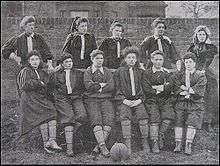Nettie Honeyball
Nettie Honeyball, also referred to as Nettie J. Honeyball,[1] was the founder of the British Ladies' Football Club, the first known women's association football club, and one of their players until spring 1895. The name Nettie Honeyball was a pseudonym, and her real name is unknown. Some people believe that her real name was Mary Hutson.[2][3][4][5] When Honeyball formed the BLFC, she was living in Crouch End, but it is not known whether she was from the area. There have been suggestions that she may have been from a middle class family in Pimlico.[3][4]

Career
In 1894, Honeyball began placing newspapers adverts for players for a women's football team. Thirty women responded, and so the British Ladies' Football Club (BLFC) was formed by Honeyball and Lady Florence Dixie in 1895, and was mainly composed of middle-class women.[6][2][5] Honeyball described football as "a manly game that could be womanly as well."[7] Due to Honeyball's PR campaign, the BLFC's first match in 1895 had an attendance of over 12,000 people.[8] Scottish suffragist Helen Matthews, known for forming Mrs Graham's XI, played for the BLFC in 1895.[3] Honeyball's last recorded appearance for the BLFC was on 13 May 1895.[1][3]
References
- Brennan, Patrick. "Nettie Honeyball". Donmouth. Patrick Brennan. Retrieved 15 February 2012.
- "The Honeyballers: Women who fought to play football". BBC News. 26 September 2013. Retrieved 13 May 2017.
- Tate, Tim (August 2013). Girls with Balls - The Secret History of Women's Football. John Blake Publishing. Retrieved 13 May 2017.
- Lee, James (September 2013). The Lady Footballers: Struggling to Play in Victorian Britain. Routledge. pp. 17–26. Retrieved 13 May 2017.
- "From Honeyball to Houghton". FIFA. 24 October 2013. Retrieved 13 May 2017.
- Domeneghetti, Roger (April 2017). From The Back Page To The Front Room: Football's Journey Through The English Media. Ockley Books. Retrieved 13 May 2017.
- Mangan, J A (November 2013). Sport in Europe: Politics, Class, Gender. Routledge. p. 28. Retrieved 13 May 2017.
- Harris, Tim (November 2009). Players: 250 Men, Women and Animals Who Created Modern Sport. Random House. Retrieved 13 May 2017.